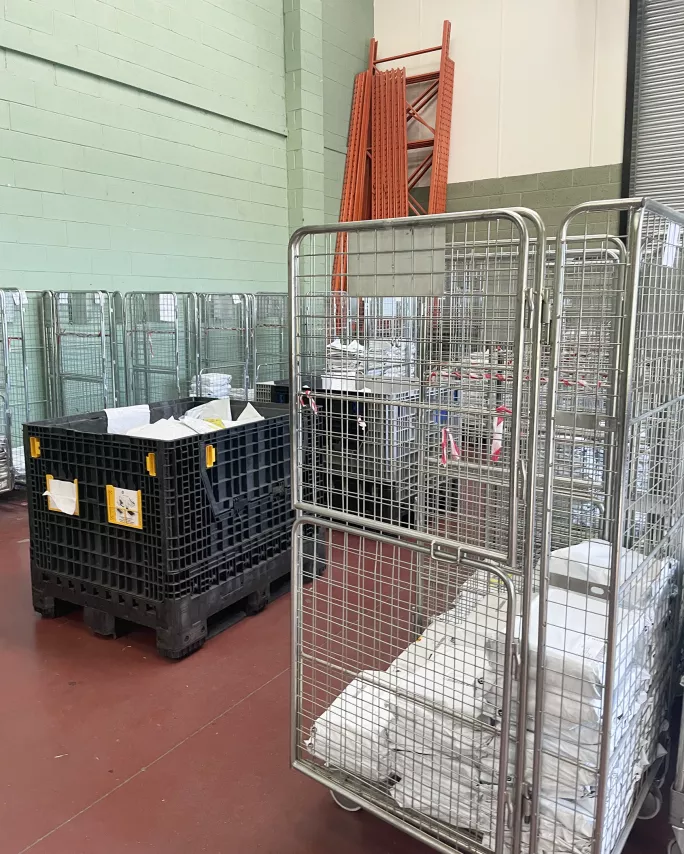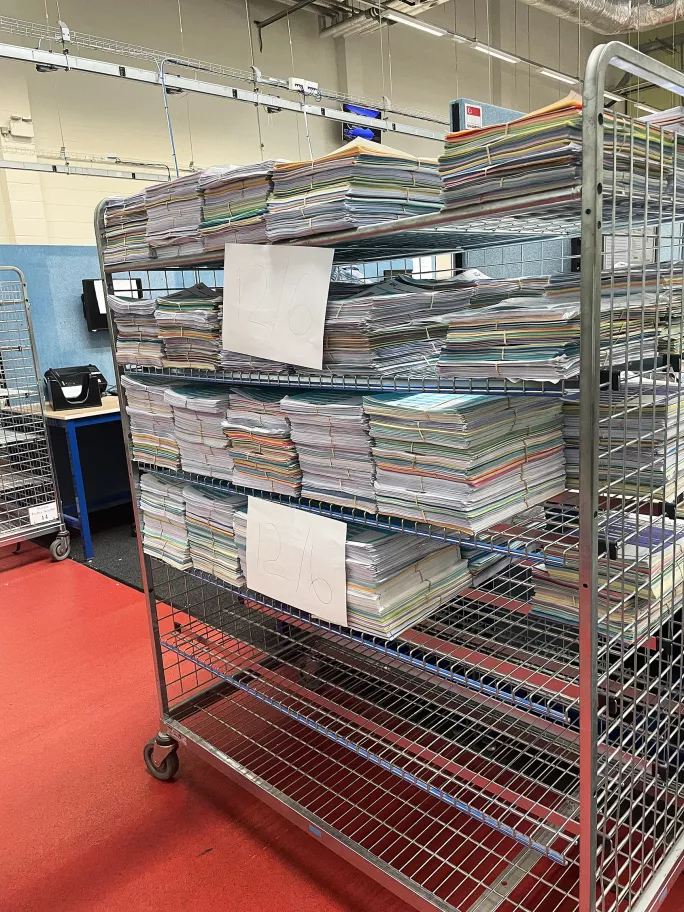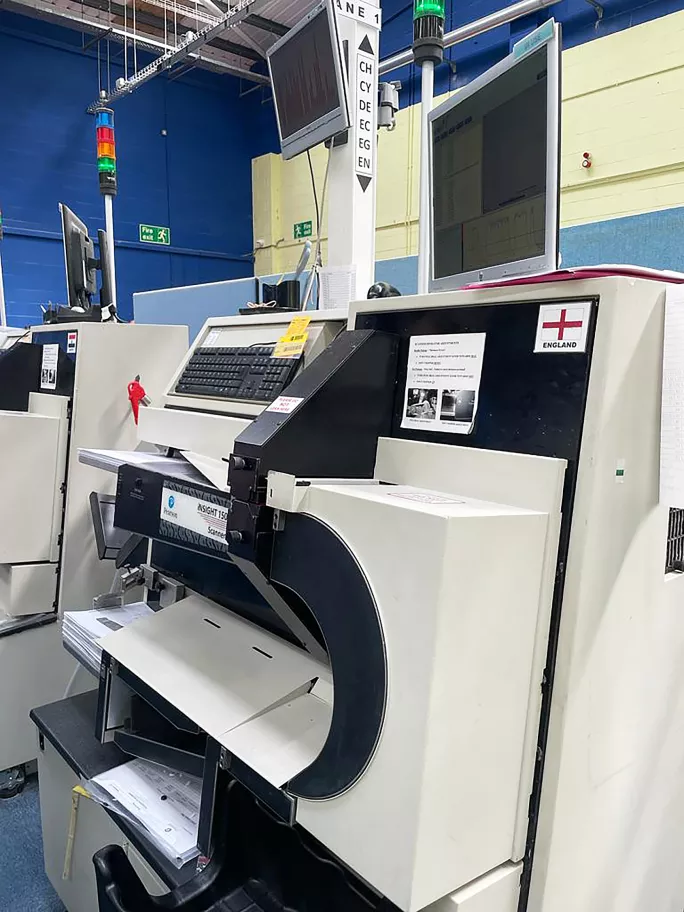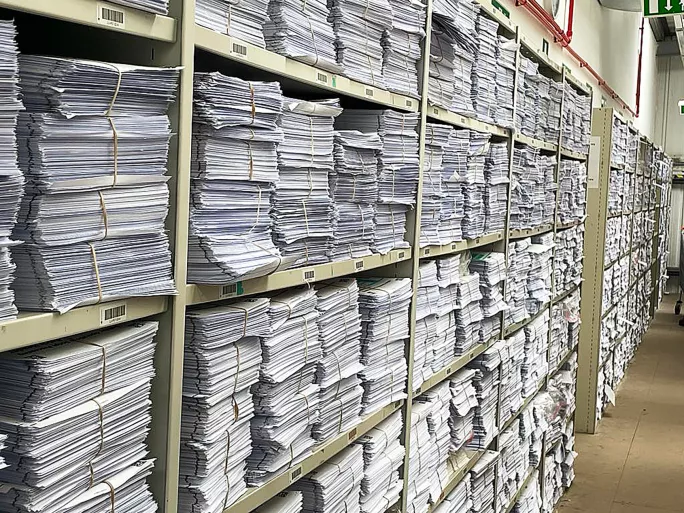Inside the factory: how 9 million exams are prepared for marking

This article was originally published on 7 August 2023
Throughout May and June, vans containing exam papers and blank exam scripts zoom across the country delivering GCSE and A-level papers to secondary schools and colleges.
These booklets become the all-encompassing focus for students for a few brief hours as they are pored over in exam halls.
Then the buzzer sounds and they are dutifully collected in, packaged up and sent away again - disappearing into the back of vans and out of the school gates.
If teachers or students consider what happens to these scripts once they have left, they probably think mostly of an examiner somewhere, working their way through reams of questions that will be of vital importance in a few weeks.
But how do the scripts reach the examiners in the first place? The answer is - the exam factory.
Usually off limits to the public, Tes was given exclusive access to the Pearson Edexcel exam processing centre in Hellaby, Yorkshire, to find out what goes on inside the exam factory and how over nine million exam scripts are processed and prepared for exam marking each and every year.
- Results 2024:GCSE results day: all you need to know
- Appeals: How to appeal an A-level or GCSE grade
- Clearing: Key dates for university applicants
Exam marking: how papers are prepared
While the idea of an exam factory may sound slightly fantastical, the reality is the processing centre is housed in a huge building in an industrial park, tucked away between a generic warehouse storing mechanical products and a FedEx depot.
During our visit, we witnessed one of the many huge lorries arriving to deliver scripts - where bales of parcelled-up exams are removed by the factory staff. In a single day, 30,000 bundles of exams can be taken into the factory.
WATCH: Exam scripts are delivered
The video itself may not make the cut in the next Mission Impossible, but the hopes, dreams, aspirations and future life choices of millions of students are contained within - with GCSE, A level, international GCSE, International A-level, Btecs and functional skills papers all processed at the plant.
Tracking the exam papers
Once the scripts are inside the factory, the tracking begins - no easy task with so many different papers to process.
To make this whole process work, each bundle of scripts contains a barcode for the exam centre and a paper number.
These are scanned to log their arrival, and then they are sorted into relevant bundles and placed in cages to keep them safe.

Once the cages are full, they are taken to the next processing stage to prepare to be opened and placed on black trays that will enable them to travel around the site - a bit like how your suitcase moves through the airport.

Now the bundles of scripts are nearly ready to be opened - however, that process is still a couple of steps away.
Before that, the black trays slide to the other side of the shelving unit, ready to be loaded onto a conveyor belt - but to avoid an exam paper pile-up, they can only be taken off and loaded on when the red light comes on to signal the system is ready for another batch of papers to be sent around.

When they are ready, a worker takes each tray and loads it onto a conveyor belt… meaning they probably have the claim to fame of handling more exam papers than anyone else in the country, maybe in the entire world.
In a single day, up to 1,250,000 exam papers can make that journey around the conveyor belt.
WATCH: Exam scripts on a conveyor belt
The exam bundle openers
Next, we meet the bundle openers. This part of the process is key to ensure that no loose pieces of paper or damaged exam papers are missed.
To do this, workers cut open the plastic wrapping and turn it inside out to check no loose sheets have been caught in the packaging or are missed - pretty important if you have students who write at a rapid pace or need extra space to show their working.
Furthermore, any accessible papers (this includes large print scripts or scripts printed on coloured paper) are separated from the other scripts as well.
The video below shows someone checking one of these bundles.
WATCH: Exam scripts being opened and checked
The staff checking the paper also ensure that the correct type of pen has been used to complete the exam.
Written in a pen with light blue ink? Too thick? Too faint? These papers are separated out as they won’t be able to be scanned (more on this soon).
And what about the exam scripts that have arrived, but nobody was expecting them? Or have arrived and it isn’t clear who the candidate is? Or the centre?
All of these papers are “the exceptions”, and they go to sit on their own “in quarantine”. At this point, workers will manually go through these scripts to understand if and how they should be processed.
This could be as simple as correcting the centre on the exam paper or if the paper has ink that is too thick, for example, sending it to a special scanner.
In the most extreme examples, if a paper cannot be scanned, it will be sent to someone for entirely manual marking.

Usually, though, the issue can be resolved and these papers join the others in the queue to have their spines removed - you can see this less-gruesome-than-the-name-suggests process in the video below.
Why do we have to remove the spines, I hear you ask?
Well, this is because the pages are sent through scanners so that each and every single exam page can be digitised before being sent to examiners to mark on screen at home. (If you thought exams were still marked by hand, you’re stuck in the 1990s - but don’t worry we’ll explain more about this later.)
WATCH: Exam scripts having their spines removed
This procedure results in many cast-off strips of paper - 180 bags worth, in fact.
And what if it later transpires that one of those spines contained important words missing from the exam paper? Then someone is digging through these bags to find it.
This happens more than you may imagine. Thanks to the barcodes, which you may have spotted before on the exam papers, though, they can be easily reunited to ensure that any writing which strayed over the spine edge will be included in any marking. Phew.

The paper scanning process
Now, finally, the scripts are ready to be scanned. If you thought you were a fast reader, you’ve got nothing on these machines.
They can process 15,000 pages in 60 minutes - which is pretty handy given that between all 48 of them, they have to handle 3.5 million pages each day.
They are also pretty noisy and, as they are running from 6am to 9.30pm, earplugs are a must.
WATCH: Exam scripts being scanned in a machine
At the centre, there are multiple scanners to do this work - and it probably comes as no surprise that an exam factory likes to rank the performance of its machines.
To do this, each one is named after a country - you can see England below - while Germany, Scotland, China and Denmark are also included.

The performance of each country - ie, the scanner - is then logged on screens so that workers can compare themselves to each other, adding an element of competition to proceedings.

Each paper now has its question digitally “chopped up” into “items”. These items are sent off to examiners to mark - so they never see a whole paper in its entirety, but instead mark the same question from each paper with the aim of ensuring consistency on how each question is marked.
And there are an awful lot of questions to chop up - all of those question papers convert into 105,112,711 different items that need to be marked.
The retirement home for finished exams
Once all the papers have been scanned and you have a digital picture, the exam paper is no longer needed. The papers are now redundant, their one purpose in life fulfilled.
Just to be safe, though, the lorries return and take the papers away to another warehouse a short drive away. Here the papers are stored for six months in case any appeals or queries about the paper itself need to be checked.
Each stack of papers has a barcode, so if a problem arises with a script, they can easily locate it and refer to the physical copy.
Once this six-month deadline has passed, and the exam factory has taken all it needs from the exam script, the papers will be sent to be recycled and the shelves cleared - ready for the whole process to start again next year.

Grainne Hallahan was senior analyst at Tes
For the latest education news and analysis delivered directly to your inbox every weekday morning, sign up to the Tes Daily newsletter
You need a Tes subscription to read this article
Subscribe now to read this article and get other subscriber-only content:
- Unlimited access to all Tes magazine content
- Exclusive subscriber-only stories
- Award-winning email newsletters
Already a subscriber? Log in
You need a subscription to read this article
Subscribe now to read this article and get other subscriber-only content, including:
- Unlimited access to all Tes magazine content
- Exclusive subscriber-only stories
- Award-winning email newsletters
topics in this article



